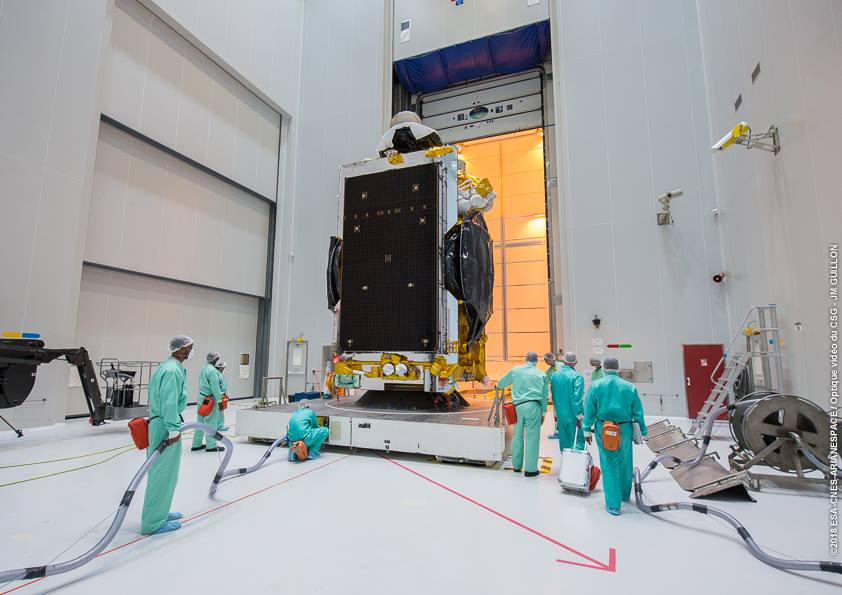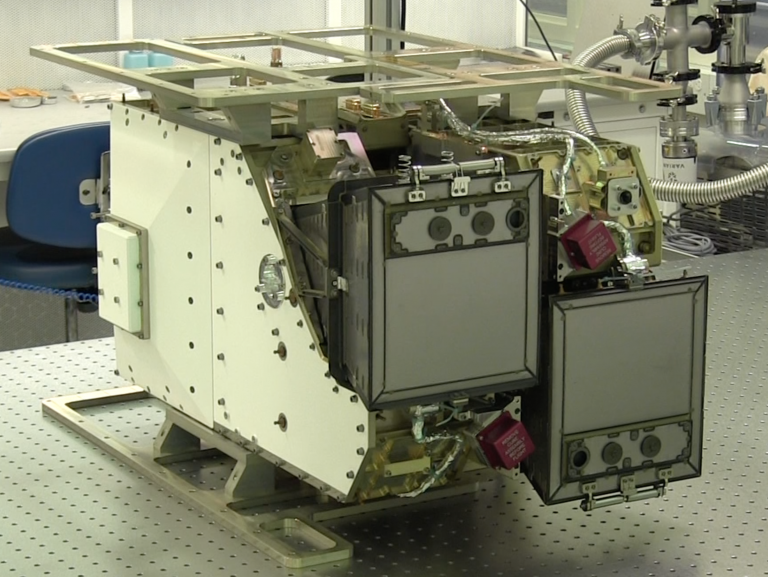
A $66 million NASA-funded science sensor package bolted on to a commercial communications satellite is ready for a ride toward a 22,000-mile-high orbital perch Thursday on a European Ariane 5 rocket, commencing a two-year mission surveying a rarely-studied region of Earth’s upper atmosphere.
The Global-scale Observations of the Limb and Disk, or GOLD, instrument is mounted on the SES 14 satellite, a commercial telecom craft awaiting liftoff Thursday from the European-run Guiana Space Center on the northern coast of South America.
Developed by scientists at the University of Central Florida and the University of Colorado-Boulder, GOLD will map the composition and temperature of the upper atmosphere across the Western Hemisphere once every 30 minutes. Researchers said the instrument will yield a better understanding of how layers of the upper atmosphere — the thermosphere and ionosphere — react when bombarded with radiation from the sun above or influenced by weather systems below.
Data from GOLD could help improve space weather forecasts, providing better warnings of events that could spark auroral storms, communications and navigation outages, disruptions to aviation, and danger for astronauts and satellites.
“What we wanted to do is to get the big picture,” said Richard Eastes, a scientist at the University of Central Florida who conceived of the GOLD instrument. “For years, we’ve been studying the Earth’s upper atmosphere — the thermosphere and ionosphere we call it sometimes — and we’ve been looking at those in detail from the ground and from low Earth orbit missions.”
GOLD will ride with the SES 14 communications satellite to geostationary orbit, a location nearly 22,300 miles (nearly 36,800 kilometers) over the equator. At that altitude, the spacecraft will move around Earth at the same rate of the planet’s rotation, giving GOLD a fixed field-of-view from high altitude.
Large broadcasting satellites are often launched into geostationary orbit because it allows ground-based antennas to connect with the spacecraft by pointing at the same place in the sky at all times.
“We wanted to be able to back off and look at it from geostationary orbit and get the big picture, get a whole hemisphere at once,” Eastes said. “That lets us put things into context, things that we can’t understand when we’re just looking at one little piece. But also, at the same time, we wanted to get pictures of the temperatures (in the thermosphere and ionosphere), which is something we haven’t had before.”

Eastes and other scientists want to know how violent geomagnetic storms triggered by outbursts from the sun alter the composition and temperature of the upper atmosphere.
The ionosphere is an expansive region of the outer atmosphere, stretching between 30 miles and 600 miles (48 to 965 kilometers) above Earth’s surface. The Earth’s mesosphere, the region where meteors burn up, overlaps the lower part of the ionosphere, and the thermosphere contains the ionosphere’s outer portion.
Many orbiting satellites, including the International Space Station fly through the ionosphere, which contains electrons and ionized atoms, and responds to changing solar activity levels by shrinking or expanding.
“We have radio signals from our communications sateliltes and from our GPS satellites passing down to the ground to our cell phones and GPS navigation systems that have to go through the ionosphere,” said Sarah Jones, mission scientist for GOLD at NASA’s Goddard Space Flight Center in Maryland. “The ionosphere is a very dynamic place with a lot of structuring, and as the structure develops, it can actually garble all of these signals that are coming through our atmosphere.
“It’s more variable than we had realized in the past, and its actually an exciting opportunity for GOLD to now take a look and help us to understand how the ionosphere affects our day-to-day life,” Jones said.
She said the GOLD mission is studying “what’s essentially a new area of scientific research” by examining how the ionosphere responds not just to solar activity, but also weather patterns below it.
“In the past, people thought that this region of the Earth’s upper atmosphere was affected primarily by what’s happening at the sun,” Jones said.
“The sun’s magnetic field also interacts with the Earth and causes things like geomagnetic storms and other effects that we refer to as space weather,” she said. “However, in the last 10 years or so, there’s been this growing body of evidence that the upper atmosphere is also affected by what’s going on below, like the terrestrial weather, which is the weather that we experience every day here on Earth.”
GOLD will also detect the nighttime airglow coming from the upper atmosphere at night.

Credits: NASA
Space weather’s effects on the ionosphere are “interacting with spacecraft, sometimes disrupting them, and it even creates a really nasty environment for astronauts,” said Alex Young, associate director for heliophysics science at Goddard. “So understanding that is important also for space travel near the Earth and throughout the rest of the solar system.”
Built by the Laboratory for Atmospheric and Space Physics at the University of Colorado, the GOLD instrument contains a high-resolution, far-ultraviolet imaging spectrograph. From its position in geostationary orbit, GOLD will get a complete view of an entire hemisphere of Earth.
Past missions that studied the ionosphere had satellites that flew through the region and sampled conditions directly.
“The great thing about this orbit is the orbit stays above one location on the Earth, and that allow us to keep reviewing the same location on Earth over and over,” Eastes said. “That lets us follow the evolution in time, throughout the day, of the upper atmosphere.”
NASA has another mission — the Ionospheric Connection Explorer, or ICON — set for launch in the coming months to collect more measurements from the upper atmosphere. Jones said GOLD and ICON will make tandem observations.
“The ICON mission is launching later this year, and it consists of a suite of instruments that will be flying in low Earth orbit studying a science that is very similar to what GOLD is studying, but, of course, from a very different vantage point,” Jones said.
“ICON will be flying through that very region, directly meausuring the particles there and how they move,” she said. “That means that ICON will be getting a very localized view with fine scales, in contrast to GOLD, which is hovering 22,000 miles above seeing the whole global scale, and watching everything play out below.”
NASA selected the GOLD instrument from several proposals in 2013, after a multi-year concept study by Eastes’ team.
Eastes wanted to place the sensor in geostationary orbit, a location populated with numerous commercial and military communications satellites. He knew finding a satellite with an owner willing to host the GOLD instrument would significantly reduce the mission’s cost, giving it a better chance of jumping from the drawing board to reality.
“The initial conversations (I had) was that I was looking for a ride,” Eastes recalled.
“I called up a a few satellite companies looking to see who has satellite and who’s flying them, and I realized communications companies are flying lots of satellites,” he said. “That was the place to go.”
NASA paid SES, a company based in Luxembourg with one of the largest geostationary fleets, to host the GOLD instrument on its SES 14 spacecraft once the operator agreed to the plan.
The hosted payload arrangement is not unique. Space industry officials, military leaders and scientists have advocated for more hosted payloads for years, but the projects have often run into negotiating roadblocks when managers attempt to merge the needs of a host satellite with the requirements of a secondary instrument box.
Todd Gossett, senior director of hosted payloads at SES Government Solutions, said instruments like GOLD take advantage of their host satellite’s power and telemetry capabilities, along with a ground station network. And NASA did not have to pay for all the launch costs.
“What does all this mean? A hosted payload customer can oftentimes use a hosted payload to save tons of money, up to hundreds of millions of dollars, versus procuring a dedicated satellite on their own,” Gossett said.
The GOLD instrument was delivered to Airbus Defense and Space, SES 14’s manufacturer, last year at the company’s production site in Toulouse, France, where engineers installed the sensor and ensured its compatibility with the satellite.
NASA’s budget for GOLD amounted to $66.3 million, around $6.7 under the planned cost, according to Dwayne Brown, an agency spokesperson.
Controllers at the University of Colorado will oversee GOLD’s activities in space, while a science center at the University of Central Florida will catalog and analyze the results.
GOLD is scheduled for blastoff Thursday at 2220 GMT (5:20 p.m. EST) aboard a European Ariane 5 rocket from Kourou, French Guiana. It will be the first of up to 14 Arianespace missions planned for 2018.
The SES 14 satellite’s primary purpose is to provide aeronautical and maritime mobility connectivity, wireless communications, broadband delivery, and video and data services over North, Central and South America, the Caribbean, the North Atlantic and parts of Europe, replacing the NSS-806 satellite.
Another communications satellite, named Al Yah 3, is also awaiting liftoff on the Ariane 5 and will support broadband Internet and data services over Africa and Brazil.
Email the author.
Follow Stephen Clark on Twitter: @StephenClark1.



